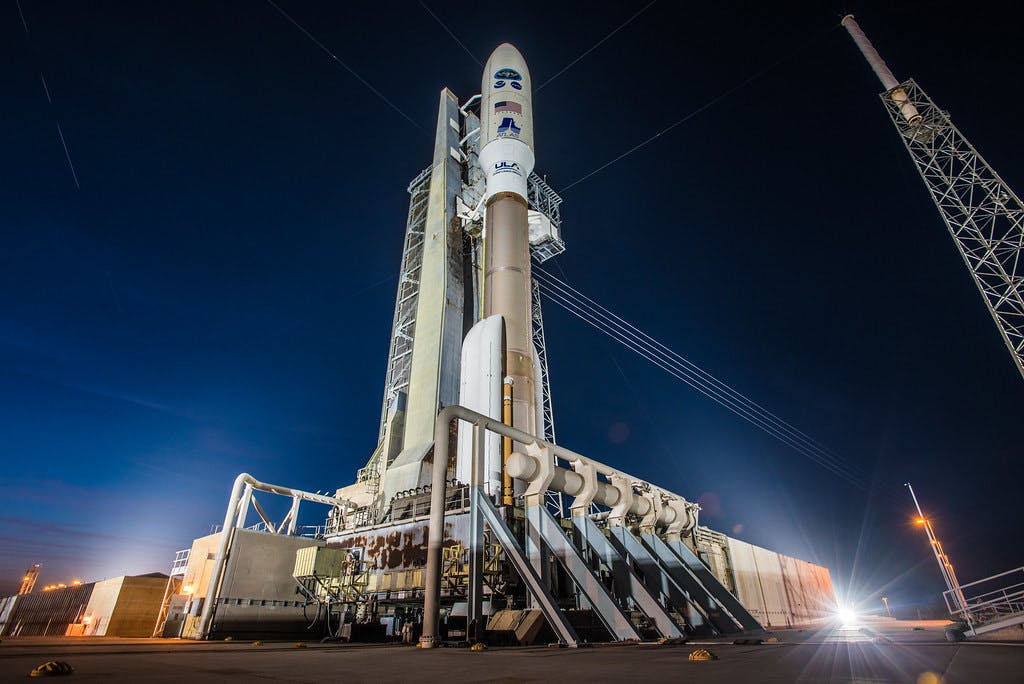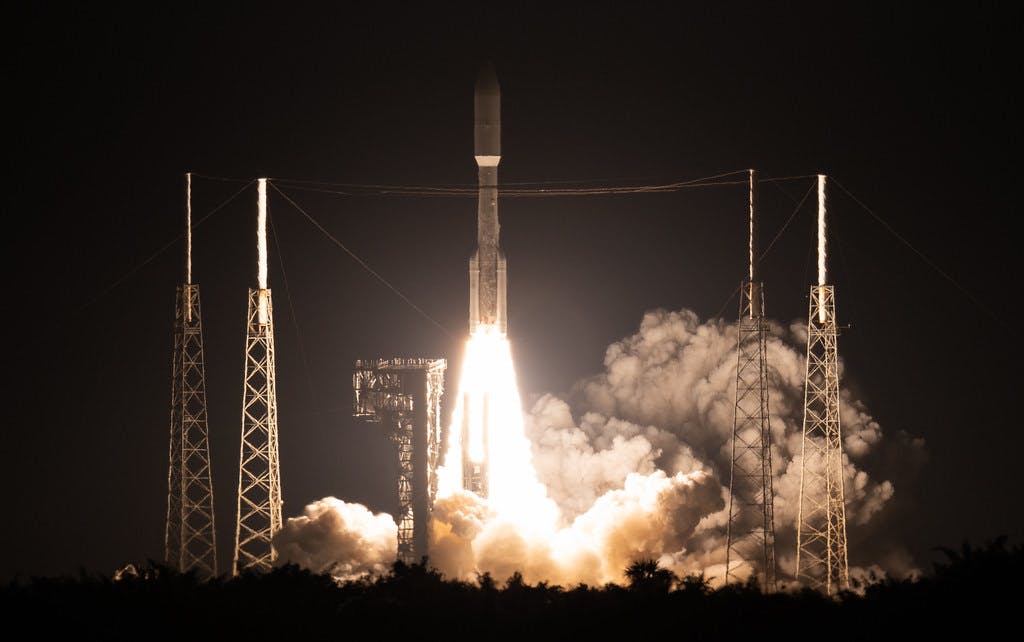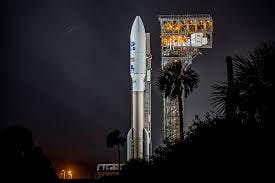Overview of United Launch Alliance (ULA): An aerospace collab on the cusp of greatness

Blog
As early as the late 1950s, private and government aerospace organizations were collaborating on space launches for profit, scientific achievement, commercial success, and political maneuvering. In fact, the first two-stage launch vehicle to place a satellite into orbit (Discoverer 1 in February 1959), as well as the first amateur-built satellite launched into orbit (OSCAR-1 in December 1961), both aboard Thor-Agena rockets, were the result of a collaboration between aerospace firms Douglas, who built the “Thor” first stage, and Lockheed, who built the “Agena” second stage.
This kind of corporate and technological team-up continues to this day, since it’s often fiscally desirable to share the workload, deliverables, and risk among two or more firms, rather than have one company try to go it alone. This approach has the potential for maximizing success, as well as profits for all parties involved. United Launch Alliance (ULA), formed in 2006, is a 50/50 joint venture between Lockheed Martin’s space division and Boeing Defense, Space & Security (BDS), and the organization has achieved significant successes to date, with big plans for the future as well.
Let’s take a closer look at what happens when large, successful aerospace firms decide to play together, and some of the regulatory and technological problems they have faced along the way.

United Launch Alliance boasts an impressive 100% mission success rate
There was a time when the private or commercial launching of space rockets and satellites was inconceivable to most people, who assumed that it took the collective budgetary and technological might of the US government (or USSR) to put people and things into orbit or space. But as we’ve seen, collaborations between one or more private firms, or between commercial companies and .gov organizations, has been the bread and butter of the aerospace industry practically since the beginning.
Since United Launch Alliance was able to benefit from the rocket/missile technology and lessons learned since the 1950s with the combined history of the Thor/Delta and Atlas missiles/rockets, the joint venture company has boasted an impressive launch record from the get-go, rather than having to learn expensive–and explosive–lessons like so many of the NewSpace startups we’ve seen over the past decade or so. In fact, ULA points out that their success is at least partially “founded on a heritage of more than 600 Atlas program launches” and “nearly 60 years of [Delta] launch experience.” (Though any early failures of the Atlas and Thor/Delta missiles are conveniently ignored when citing that history.)
ULA is justifiably proud of their ability to successfully and reliably launch their rockets, claiming to be “the nation’s most experienced space launch company with more than 150 consecutive launches and a 100% mission success rate.” The company keeps a running record of ULA’s launches, the rockets used, details on the payload (if not prohibited due to national security concerns), and type of customer on their website.
ULA missions have inserted satellites that provide critical capabilities for troops in the field, aid meteorologists in tracking severe weather, enable personal device-based GPS navigation, and facilitate further exploration of our solar system.
The company says their rockets have placed more than $70 billion worth of satellite assets into orbit to this point. But in the fast-moving world of aerospace, you can’t rely on legacy launch technology or tasty government contracts forever, as we’ll see below.

To remain competitive, ULA needs to step up their game (and are planning to)
Startup space-services providers like SpaceX have taken issue with the ULA concept from day one, and SpaceX challenged the legality of the launch services “monopoly” in 2005, when the joint venture was first being proposed, on antitrust grounds. After review, the Federal Trade Commission gave ULA antitrust clearance for the formation of the joint venture on 3 October 2006. However, conflict and competition between ULA and SpaceX has only increased since. When a major $11 billion contract was awarded to ULA in 2013, SpaceX protested the (at the time) $460 million per launch cost (according to SpaceX), saying that SpaceX could provide the same services for $90 million each. ULA was forced to cut costs to respond, and has gone through several CEOs and laid off a significant number of its executives over the years in an attempt to stay competitive.
Elon Musk has famously disparaged ULA multiple times, tweeting as recently as August 2020 that ULA’s rockets are “a complete waste of taxpayer money.” As Jason Jennings said, “It’s not the big that eats the small… it’s the fast that eats the slow.” ULA has had its share of successes, netting lucrative contracts with NASA, the US Department of Defense, and other prominent organizations. But the joint venture firm can’t afford to rest on its laurels, because small, hungry, young companies like SpaceX are not only nipping at ULA’s heels, but positively putting them to shame in some important areas.
Ars Technica pointed out in 2022, “SpaceX has taken its [launch] cadence to another level, with a mix of payloads including its Starlink satellites, crew and cargo missions for NASA, Department of Defense missions, and commercial satellites. As of Monday, the Falcon 9 rocket has launched every 6.4 days this year and has lofted nearly 300,000 kg into low Earth orbit. This is considerably more than every other country and company in the world combined. . . . To put this cadence into perspective, consider the flight rate of SpaceX’s main US-based competitor, United Launch Alliance. Counting both its Delta and Atlas fleets, ULA launched its last 31 rockets from March 19, 2017, to the present day. That’s a cadence of one launch every 64 days. [But] SpaceX is now launching at a rate of 10 rockets to every one of its main American competitor [emphasis added]. Both companies have 100 percent success rates during this time period.”
This may look pretty grim for ULA’s future. However, as Ars Technica points out, ULA has a chance to make important inroads in the “heavy lift” launch space in the coming years, and will soon debut its new heavy lift Vulcan rocket, likely during the first half of 2023. “With a lengthy launch manifest that includes both institutional customers and Amazon's Project Kuiper, the company’s cadence should increase significantly. This likely will come sometime in the mid-2020s as ULA scales up its operations and Vulcan production capabilities.”
TechTarget says ULA’s Delta 4 Heavy, which at one time was the world’s most powerful operational rocket, can send nearly 32 tons of payload (more than the weight of two standard school buses) into low-Earth orbit per launch. However, at least partially in an attempt to compete with or surpass the capabilities of SpaceX’s Falcon Heavy and Starship rockets, ULA’s forthcoming Vulcan rocket “will be able to boost 80,000 pounds to low-Earth orbit; or up to 35,900 pounds to the elliptical geosynchronous transfer orbits (GTO) used by communications satellites,” according to the report.
Recently, all elements of ULA’s new Vulcan have arrived at Cape Canaveral and in the coming weeks and months will be assembled for its inaugural launch. You can keep track of the progress on ULA’s Countdown to Vulcan webpage.
Since neither SpaceX’s Starship nor ULA’s Vulcan have successfully launched to date, the bragging rights and potential big bucks of private heavy-payload space delivery services are still largely up for grabs. We’ll be keeping a close eye on these two aerospace heavyweights to see if they can peacefully coexist, or whether one finally gets knocked down for the count.
–By Jeff Davis, Intergalactic Scribe
Sources:
https://www.ulalaunch.com/missions
https://en.wikipedia.org/wiki/United_Launch_Alliance
https://www.techtarget.com/whatis/definition/United-Launch-Alliance-ULA